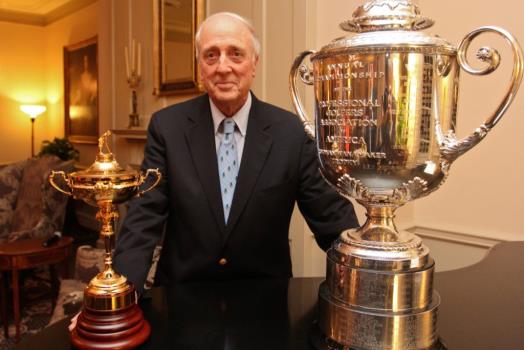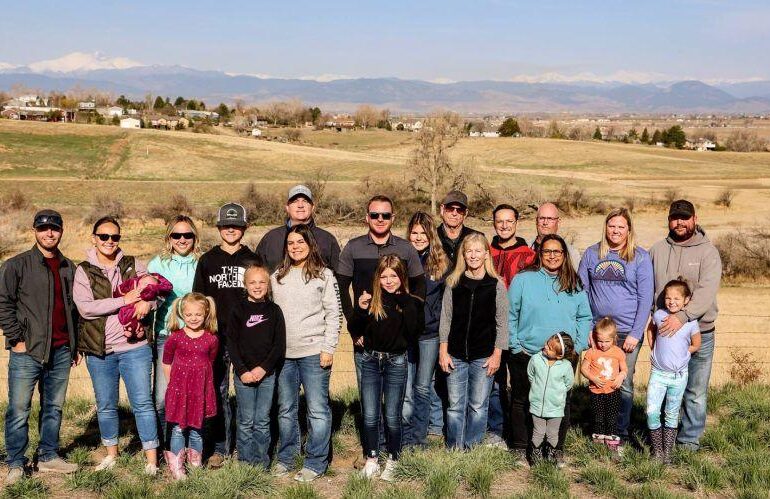
Rees Jones pictured with the Ryder Cup and Wanamaker Trophy, awarded to the winner of the PGA Championship. The Black Course at Bethpage State Park will host the 2025 Ryder Cup.
photo by Rees Jones, Inc.
Nashville’s stately Belle Meade Country Club has established a well-deserved reputation as one of Tennessee’s iconic golf courses, oozing with history and prominence since its inception in 1901 a few miles away before relocating to its current site twenty years later.
Having hosted countless state and regional championships and with the Tennessee Senior Amateur and Super Senior Amateur being held at the club for the first time this week, Belle Meade is one of those places that has contributed to the fabric of Tennessee golf on a national scale.
Its reputation and status certainly caught the attention of the USGA power brokers. Belle Meade was the site of the inaugural U.S. Senior Amateur Championship in 1955, and a long-awaited return will occur with the arrival of the 2028 U.S. Senior Women’s Amateur along with the 2036 U.S. Senior Amateur.
By comparison, one would be hard-pressed to find a golf course that represents a more dissimilar persona to Belle Meade than the Black Course at Bethpage State Park on New York’s Long Island, site of the 45th Ryder Cup in late September.
A public access layout that is one of five 18-hole golf courses in the park, Bethpage Black is anything but refined and proper. Instead, it is blue-collared and brazen, rough around the edges with a New York-style vibe that is not for the faint of heart.
But there is a common thread that connects both Belle Meade and Bethpage Black, someone with intimate knowledge of what makes both places special in their own unique way. And that thread is found in legendary golf course architect Rees Jones, who had a strong influence in bringing about the renaissance of both designs.
Jones has designed or renovated more than 270 golf courses in his illustrious career, having developed his own style of timeless design with an emphasis on environmental awareness. He has earned the moniker “The Open Doctor” for his work in preparation for numerous major championships. His renovation and restoration skills have been applied to seven U.S. Open venues, nine PGA Championship courses, six Ryder Cup and two Walker Cup sites as well as three Presidents Cup venues.
In other words, when Jones takes on a project, the final outcome will be memorable. Rather than simply moving dirt around to construct a series of golf holes, Jones uncovers gems within a property by flushing them to the surface in an organic fashion, weaving it all together to feel both memorable and seamless.
A recent example of Jones’ spectacular handiwork can be witnessed atop Lookout Mountain outside of Chattanooga, where he collaborated with Bill Bergin to design the mountain top marvel known as The Keep at McLemore Resort.
This undertaking was on the heels of the design tandem’s extensive makeover to the resort’s original golf course, The Highlands, that drew rave reviews for its unparalleled finishing hole seemingly suspended in air above the valley below. The Keep offers that experience on steroids, with five cliff-edge holes that will surely become a bucket list item for all levels of golfers since its soft opening last fall.
Jones’s father, Robert Trent Jones Sr., had a hand in updating Belle Meade in the 1950s that was originally completed by noted designer Donald Ross. In 2002, it was time for the son to offer his expertise in bringing the next wave of renovation to the club.
“We put the Donald Ross character back into the greens and bunkers, and we rerouted and moved a few holes,” Jones said. “I think the beauty of this golf course is it’s a thought-provoking golf course. It’s a wonderful course for every caliber player, and it’s manageable. You do have to think your way around it, and they have a wonderful membership who I enjoyed working with.”
Even though it has been more than two decades since Jones’ restoration at Belle Meade, he was able to rattle off an overview of each hole during our conversation along with the changes completed, completely without any notes as if he were being asked to recite the names of his children.
The same was true when the topic of Bethpage came up, a place where his name has become closely associated given his expertise in transforming that golf course into the best version of itself.
Jones was hired to conduct a major restoration at Bethpage Black in the late ‘90s in preparation for the 2002 U.S. Open won by Tiger Woods. He made additional design improvements prior to the 2009 U.S. Open and 2019 PGA Championship, and has again been tasked with implementing revisions for the upcoming Ryder Cup.
Over the last 25 years, Jones’s impact at Bethpage has certainly been substantial, but the course’s sheer challenge has never changed. Bethpage Black was originally modeled after Pine Valley and is still as formidable a test as original designer A.W. Tillinghast created in 1936.
“The beauty of Bethpage is it gives you an opportunity to have a true championship test,” Jones said. “The players are really challenged by it, but they love the place. It’s an old-style golf course that’s fair.”
With massive crowds expected for the Ryder Cup, one of the challenges Jones faced was reworking the area surrounding the first tee.
“That decision was predicated by the need for the viewing stands,” Jones said. “They took out our tee for the stands, and those will be the biggest tickets out there. That was just one of the few challenges we faced.”
Bethpage should provide a formidable challenge for the visiting European team, with the rowdy New York fans giving the Americans the advantage of competing on home soil. It will serve as the next chapter in Jones’ influence on the game of game that stretches from Belle Meade, to Bethpage to around the globe.
Paul Payne can be emailed at paulpayne6249@gmail.com

Paul Payne
photo by Mike Tomshack






